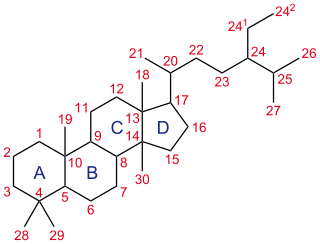
A steroid is an organic compound with four fused rings arranged in a specific molecular configuration.

Progestogens, also sometimes written progestagens or gestagens, are a class of natural or synthetic steroid hormones that bind to and activate the progesterone receptors (PR). Progesterone is the major and most important progestogen in the body. The progestogens are named for their function in maintaining pregnancy, although they are also present at other phases of the estrous and menstrual cycles.

The adrenal cortex is the outer region and also the largest part of the adrenal gland. It is divided into three separate zones: zona glomerulosa, zona fasciculata and zona reticularis. Each zone is responsible for producing specific hormones. It is also a secondary site of androgen synthesis.

Trestolone, also known as 7α-methyl-19-nortestosterone (MENT), is an experimental androgen/anabolic steroid (AAS) and progestogen medication which has been under development for potential use as a form of hormonal birth control for men and in androgen replacement therapy for low testosterone levels in men but has never been marketed for medical use. It is given as an implant that is placed into fat. As trestolone acetate, an androgen ester and prodrug of trestolone, the medication can also be given by injection into muscle.

Steroid 11β-hydroxylase, also known as steroid 11β-monooxygenase, is a steroid hydroxylase found in the zona glomerulosa and zona fasciculata of the adrenal cortex. Named officially the cytochrome P450 11B1, mitochondrial, it is a protein that in humans is encoded by the CYP11B1 gene. The enzyme is involved in the biosynthesis of adrenal corticosteroids by catalyzing the addition of hydroxyl groups during oxidation reactions.

Mibolerone, also known as dimethylnortestosterone (DMNT) and sold under the brand names Cheque Drops and Matenon, is a synthetic, orally active, and extremely potent anabolic–androgenic steroid (AAS) and a 17α-alkylated nandrolone (19-nortestosterone) derivative which was marketed by Upjohn for use as a veterinary drug. It was indicated specifically as an oral treatment for prevention of estrus (heat) in adult female dogs.

Adrenosterone, also known as Reichstein's substance G , as well as 11-ketoandrostenedione (11-KA4), 11-oxoandrostenedione (11-OXO), and androst-4-ene-3,11,17-trione, is a steroid hormone with an extremely weak androgenic effect, and an intermediate/prohormone of 11-ketotestosterone. It was first isolated in 1936 from the adrenal cortex by Tadeus Reichstein at the Pharmaceutical Institute in the University of Basel. Originally, adrenosterone was called Reichstein's substance G. Adrenosterone occurs in trace amounts in humans as well as most mammals and in larger amounts in fish, where it is a precursor to the primary androgen, 11-ketotestosterone.

11-Ketotestosterone (11-KT) is an oxidized form of testosterone that contains a keto group at the C11 position. It is related to adrenosterone, an androgen found in trace quantities in humans. In fish, 11-ketotestosterone functions as the endogenous androgenic sex hormone. In midshipman fish, 11-ketotestosterone is not present in females or Type II Males — Type II Males reach sexual maturation later, are less territorial, and have higher testosterone than Type I Males.

11α-Hydroxyprogesterone (11α-OHP), or 11α-hydroxypregn-4-ene-3,20-dione is an endogenous steroid and metabolite of progesterone. It is a weak antiandrogen, and is devoid of androgenic, estrogenic, and progestogenic activity.

Dimethandrolone (DMA), also known by its developmental code name CDB-1321, is an experimental androgen/anabolic steroid (AAS) and progestogen medication which is under investigation for potential clinical use.

Dienolone, or nordienolone, also known as 19-nor-δ9(10)-testosterone, δ9(10)-nandrolone, or estra-4,9(10)-dien-17β-ol-3-one, is a synthetic anabolic-androgenic steroid (AAS) of the 19-nortestosterone group that was never marketed. It has been found to possess slightly lower affinity for the androgen receptor (AR) and progesterone receptor (PR) relative to nandrolone in rat and rabbit tissue bioassays, whereas trenbolone was found to possess the same affinity for the AR as dienolone but several-fold increased affinity for the PR. Dienedione is thought to be a prohormone of dienolone, while methyldienolone and ethyldienolone are orally active 17α-alkylated AAS derivatives of dienolone. In contrast, dienogest, the 17α-cyanomethyl derivative of dienolone, is a potent progestogen and antiandrogen.

11-Ketodihydrotestosterone (11-KDHT), also known as 5α-androstan-17β-ol-3,11-dione, is an endogenous, naturally occurring steroid and androgen prohormone that is produced primarily, if not exclusively, in the adrenal glands. It is closely related to 11β-hydroxyandrostenedione (11β-KA4), adrenosterone, and 11-ketotestosterone (11-KT), which are also produced in the adrenal glands.

11β-Hydroxyprogesterone (11β-OHP), also known as 21-deoxycorticosterone, as well as 11β-hydroxypregn-4-ene-3,20-dione, is a naturally occurring, endogenous steroid and derivative of progesterone. It is a potent mineralocorticoid. Syntheses of 11β-OHP from progesterone is catalyzed by the steroid 11β-hydroxylase (CYP11B1) enzyme, and, to a lesser extent, by the aldosterone synthase enzyme (CYP11B2).

5α-Dihydronorethisterone is a major active metabolite of norethisterone (norethindrone). Norethisterone is a progestin with additional weak androgenic and estrogenic activity. 5α-DHNET is formed from norethisterone by 5α-reductase in the liver and other tissues.

The androgen backdoor pathway synthesizes physiologically relevant androgens from 21-carbon steroids (pregnanes) via 5α-reduction, bypassing testosterone. This differs from the conventional, canonical androgenic pathway, which involves testosterone.

5α-Pregnan-17α-ol-3,20-dione, also known as 17α-hydroxy-dihydroprogesterone (17‐OH-DHP) is an endogenous steroid, a metabolite of 17α-hydroxyprogesterone.

5α-Pregnane-3α,17α-diol-20-one, also known as 17α-hydroxyallopregnanolone (17-OH-allo) is an endogenous steroid.

11-Ketoandrosterone is an endogenous steroid.

11β-Hydroxytestosterone is an endogenous steroid, a metabolite of testosterone. Although it may not have significant androgenic activity, it may still be an important precursor to androgenic molecules.

5α-Pregnane-3α,11β-diol-20-one, abbreviated as 3,11diOH-DHP4, also known as 3α,11β-dihydroxy-5α-pregnan-20-one, is an endogenous steroid.





















